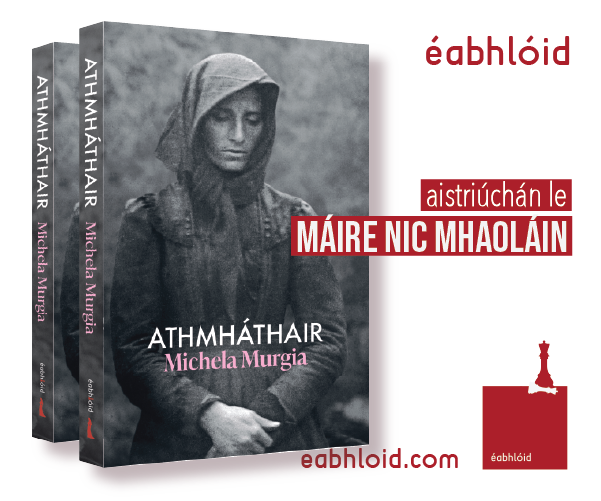Jenifer Ní Ghrádaigh of Cois Life talks about publishing contemporary teenage fiction and confounding expectations as Gaeilge
OPINION
There’s nothing I like more than reading. First drafts, finished drafts, proofs, the book itself at last in print … But for excitement nothing can beat a first draft. And so, last April when I saw that email, ‘Re: Nóinín’, I’d been waiting for in my inbox, I couldn’t resist. Click-click on the attachment (let the website orders wait!) and up it popped, the first draft of only the first half (what?!) of this year’s best teenage novel. (Yes, it’ll be out in March; just two months to wait now!) And after reading the first 60 chapterpoems of Máire Zepf ’s brilliant freeverse novel, I drew breath and thought: ‘Will she manage to keep up the momentum?’
Freeverse novels have been storming the stage when it comes to YA fiction in English, and Sarah Crossan’s The Weight of Water is now on the Junior Cert curriculum—a sure sign of establishment acceptance. Unfortunately, when the NCCA were compiling recommendations for the Junior Cycle for Irish, there was not an option to include this format, as none had yet been published. Nóinín, like many of Crossan’s novels, is told in first-person verse by two teenage voices—the eponymous heroine and her best friend. The first half of the story introduces us to the thrills of young love as Nóinín falls for a boy she meets online, but the second half, narrated by Eimear, her BFF (Buanchara Fírinneach Feasta), is altogether darker in tone. Zepf takes off the gloves to explore the void that’s left behind when Nóinín fails to return from her first real-life date with Oisín. There was one point in the story where I gasped out loud, and there’s no denying that it’s graphic in parts, although no more so than, for instance, We Come Apart and probably rather less so than Room or The Handmaid’s Tale, both of which are currently being read up and down the country as Leaving Cert texts.
The reason I mention this sort of context is because when we sent the manuscript out to external readers we got some very cautionary responses. We needed to assess the age of the target audience a bit more carefully—Nóinín was only fifteen. Wasn’t it a bit too disturbing for fifteen-year-olds? What about removing Eimear’s half and letting the readers make up their own minds as to what became of Nóinín? Alternatively, could we maybe not (spoiler alert!) have the killer hide the body in an attempt to conceal the evidence—just a bit too gruesome? And all this feedback was exactly around the time of the Belfast rape trial and the search for fourteen-year-old Ana Kriegel’s killers. Bhúps!
If there was the sort of market for Irish-language books that there is for English, we might have dismissed such concerns straight out of hand. But Irishlanguage books occupy a peculiar niche— we do receive state funding, which covers some of the costs, but, on the other hand, sales are realistically going to stand at c. 800 over five years in anything except exceptional circumstances. More substantial sales are only achievable when a book makes it onto a Junior Cert/Leaving Cert list, like Hurlamaboc by Éilís Ní Dhuibhne. We didn’t want to produce something that teachers wouldn’t want to read with a class, even though that would, in an ideal world, not be our target audience. And it’s not the first time one of our books has touched a controversial subject. Ní Dhuibhne’s Aisling nó Iníon A (2015) recounts a young girl’s secret trip to an abortion clinic in London, starting with the plane flight from Dublin. Sales have been steady but average, although improving noticeably after the Repeal referendum.
Well, we consulted Máire Zepf and decided to back her all the way. Of course, the violence was not the only point that arose. There was the language itself: there’s a lot of texting and a lot of informality. Should we allow ‘bhúps’, for instance, or correct it to either ‘ó bhó’ or ‘ababú’? Irish is evolving, and along with nice little textisms like ‘an8’ there’s no doubt that English interjections like ‘sure’ are chasing the likes of ‘leoga’ from the language. And then there’s sensitivities: ‘Bíonn pasfhocal Gaeilge ag gach Gaeilgeoir’, Eimear said at one point. But ‘Gaeilgeoir’ is not an acceptable label in Irish-speaking circles these days—it’s accumulated all that baggage to do with conservatism that is so often thrown at Irish-speakers in the English-speaking press. Nóinín was never intended to confound such expectations—it’s just a great freeverse novel for teenagers as Gaeilge. And although we never do find out what Nóinín’s password was, I can tell you now: ‘Bíonn pasfhocal Gaeilge ag gach Gael’.
Jenifer Ní Ghrádaigh is Publishing Officer in the Irish-language publishing house, Cois Life.
First published in Books Ireland magazine (January/February 2019)












